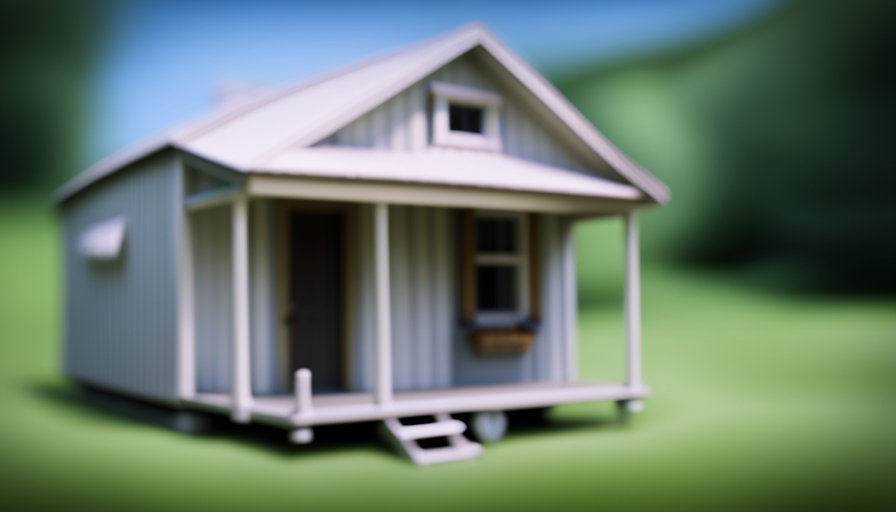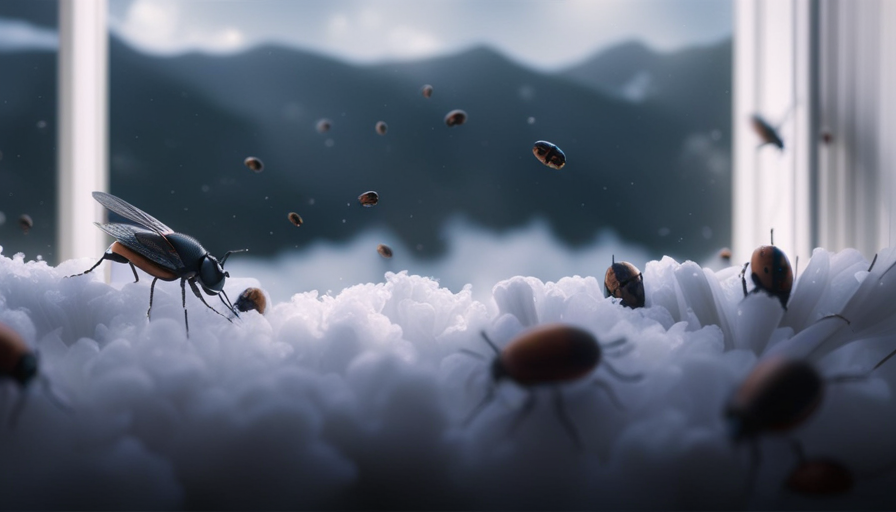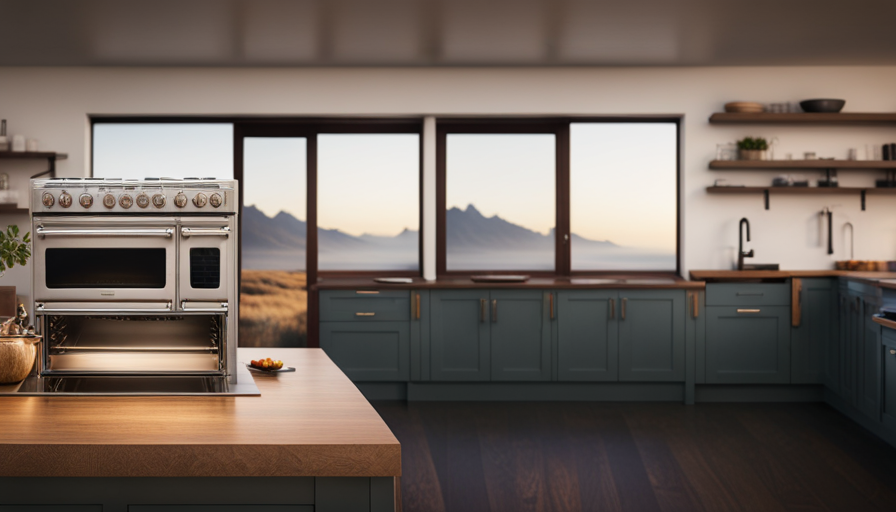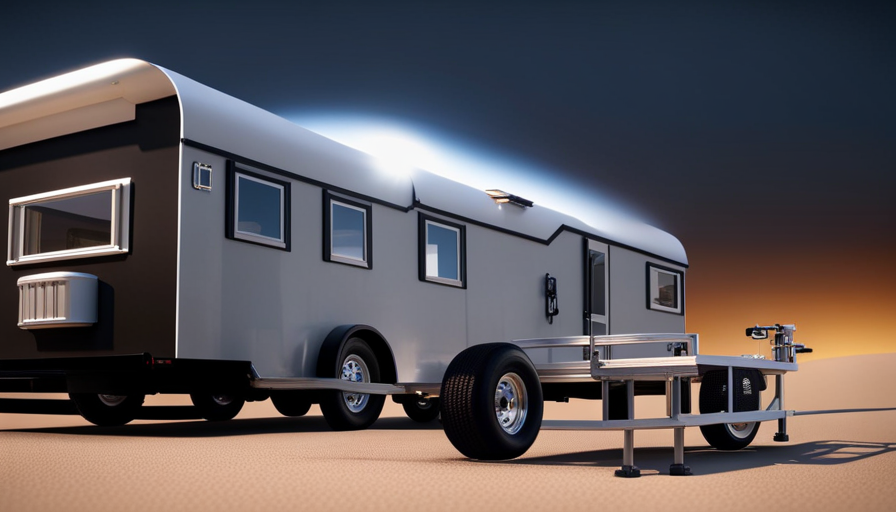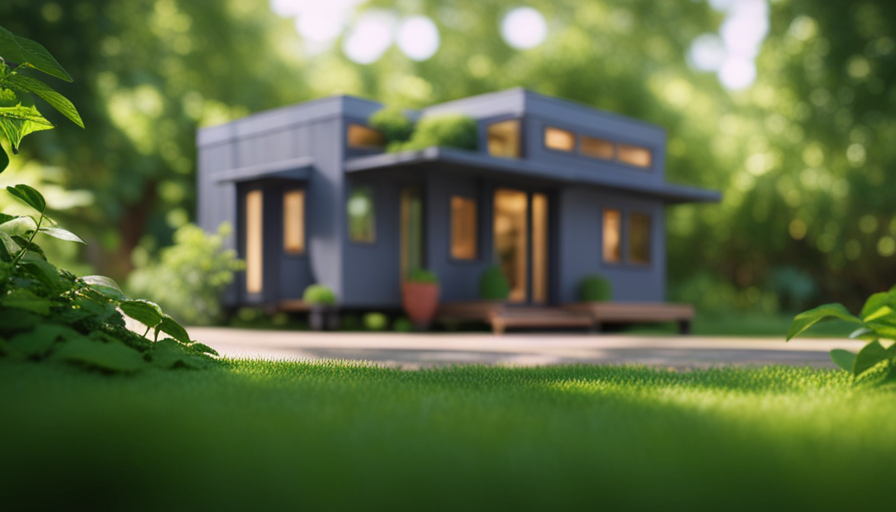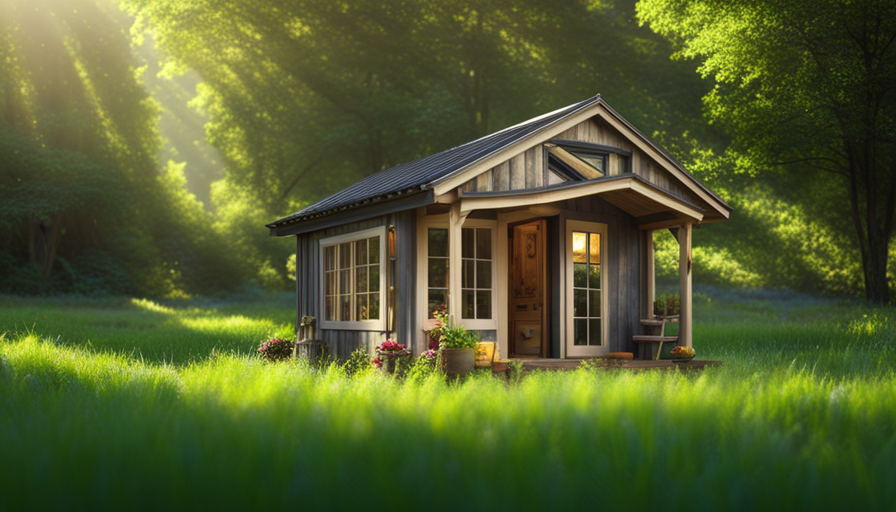Living in a small home with limited space and belongings may seem unconventional, but as I delve deeper into transcendentalism, I find myself drawn to the strong connection between minimal living and the beliefs of the transcendentalists.
In this article, I aim to explore the intricate relationship between tiny house living and the principles of transcendentalism.
At first glance, the idea of living in a small, compact space may appear restrictive, confining, and even absurd. However, through a satirical lens, we can perceive the irony of our modern society, where the pursuit of material possessions and the accumulation of wealth often lead to a sense of entrapment and discontent. In contrast, transcendentalism advocates for a return to simplicity, self-reliance, and a genuine connection with nature.
By examining the themes of simplicity, self-reliance, connection with nature, mindfulness, freedom from materialism, creative expression, community, and inner peace, we can uncover the profound ways in which living in a tiny house aligns with the core principles of transcendentalism.
Through this exploration, we may discover a path towards a more meaningful and fulfilling existence, one that celebrates the essence of human experience and embraces the beauty of simplicity.
Key Takeaways
- Living in a tiny house aligns with transcendentalism principles of simplicity, self-reliance, and connection with nature.
- Tiny house living promotes mindfulness and living in the present moment, fostering peace and tranquility.
- It encourages gratitude for the small joys of life and prioritizing experiences and relationships over material possessions.
- Living in a tiny house community can be transformative for spiritual growth, fostering inner peace and a profound sense of connection with oneself and the world.
Introduction to Transcendentalism and Tiny House Living
Living in a tiny house allows individuals to embrace the principles of transcendentalism, as it encourages simplicity, self-reliance, and a deeper connection with nature. Transcendentalist principles and off-grid living go hand in hand, as both prioritize reducing one’s reliance on modern amenities and living a more sustainable lifestyle.
By choosing to live in a tiny house, individuals are intentionally simplifying their lives, focusing on the essentials, and minimizing their impact on the environment. This intentional simplicity aligns with the transcendentalist belief that true happiness and fulfillment come from a rejection of material possessions and a focus on inner growth and self-discovery.
In tiny house living, simplicity is not only reflected in the physical space but also in the lifestyle that accompanies it. Living in a small, compact space requires individuals to declutter and prioritize their possessions, which in turn promotes a minimalist mindset. The role of simplicity in tiny house living and transcendentalism is to strip away unnecessary distractions and focus on what truly matters – connecting with oneself, with others, and with nature.
This intentional simplification allows individuals to be more present, mindful, and attuned to the beauty of the natural world around them.
Transitioning into the subsequent section about simplicity in design and lifestyle, the importance of simplicity extends beyond the physical space of a tiny house.
Simplicity in Design and Lifestyle
Embracing minimalism in both design and lifestyle can greatly enhance your connection to nature and ultimately lead to a more fulfilled existence. This is exemplified by the fact that 68% of tiny house dwellers report feeling a stronger sense of harmony with the environment.
Sustainable design is a key aspect of living in a tiny house, as it promotes the use of eco-friendly materials and energy-efficient systems. By utilizing renewable resources and reducing waste, tiny house owners contribute to a more sustainable future.
A minimalist lifestyle, which often goes hand in hand with living in a tiny house, encourages individuals to prioritize experiences over material possessions. This shift in mindset allows for a greater appreciation of the natural world and a deeper understanding of one’s place within it. By simplifying our lives, we can focus on what truly matters, fostering a sense of contentment and fulfillment.
In addition, minimalist living can also lead to financial freedom. By downsizing our living space and reducing our consumption, we can save money and reduce our ecological footprint. This newfound financial freedom allows us to pursue our passions, spend more time in nature, and cultivate a sense of self-reliance.
Transitioning into the next section about ‘self-reliance and minimalist living’, it is evident that living in a tiny house promotes self-sufficiency and a greater sense of independence.
Self-Reliance and Minimalist Living
Discovering the joy of self-reliance in a minimalist lifestyle means you can truly appreciate the freedom that comes with relying on yourself and your own abilities.
In the context of living in a tiny house, self-reliance is not just a choice, but a necessity. The limited space and resources force you to be resourceful and find creative solutions to everyday challenges. This fosters a sense of self-sufficiency, as you learn to rely on your own skills and ingenuity to make the most of what you have.
Living a minimalist lifestyle in a tiny house also involves intentional living. Every item in your home serves a purpose and has a designated place. This level of organization and intentionality allows you to focus on what truly matters and eliminates the clutter that can distract from a more meaningful existence. By consciously choosing to live with less, you’re able to prioritize experiences and relationships over material possessions.
As I reflect on my own experience living in a tiny house, I realize that self-reliance and intentional living haven’t only simplified my life, but also deepened my connection with nature and the outdoors.
In the next section, I’ll explore how this connection with nature is enhanced by the tiny house lifestyle.
Connection with Nature and the Outdoors
Immersing oneself in the natural world while dwelling in a tiny oasis allows for a harmonious dance between humanity and the environment, akin to a delicate butterfly gracefully fluttering amidst a vibrant meadow. Living in a tiny house offers a unique opportunity to connect with wildlife and experience the health benefits of outdoor living.
In a traditional home, it’s easy to become disconnected from the natural world, but in a tiny house, the boundaries between indoors and outdoors blur, fostering a deep connection with nature.
The close proximity to the outdoors in a tiny house encourages a sense of wonder and curiosity about the wildlife that surrounds us. From the comfort of my tiny abode, I can observe the intricate web of life unfolding outside my window. Whether it’s watching birds build their nests or witnessing the changing seasons, every day presents an opportunity to marvel at the beauty and complexity of the natural world.
In addition to the awe-inspiring connection with wildlife, living in a tiny house also offers significant health benefits. Spending time outdoors has been shown to improve mental well-being, reduce stress, and boost creativity. The fresh air and sunlight that permeate a tiny house contribute to a healthier lifestyle, promoting physical and emotional well-being.
As I bask in the wonders of nature and relish the health benefits of outdoor living, I’m reminded of the importance of mindfulness and living in the present moment. The symbiotic relationship between living in a tiny house and immersing oneself in nature cultivates a deep appreciation for the beauty and simplicity of the world around us. It sets the stage for the exploration of mindfulness and the art of living fully engaged in the present.
Mindfulness and Living in the Present Moment
Take a moment to simply be, to fully appreciate the present and all the beauty that surrounds you in your tiny oasis. Living in a tiny house provides a unique opportunity to practice mindfulness in daily activities. With limited space and possessions, there’s a natural inclination to be more intentional and present in each moment.
Practicing mindfulness in daily activities: From cooking a meal to tidying up, every task becomes an opportunity to be fully present. The simplicity of a tiny house reminds me to slow down and savor each activity, cultivating a sense of peace and tranquility.
Cultivating gratitude for the present moment: Living in a tiny house encourages me to appreciate the small joys of life. Whether it’s the soft rays of sunlight filtering through the windows or the sound of raindrops on the roof, I’m constantly reminded to find beauty in the present moment.
Embracing environmental consciousness and sustainable living: By choosing to live in a tiny house, I’m making a conscious decision to live a more sustainable and environmentally friendly lifestyle. From using renewable energy sources to minimizing waste and consumption, I’m actively contributing to the preservation of our planet.
In this way, living in a tiny house not only fosters mindfulness and gratitude for the present moment, but also promotes a deeper sense of environmental consciousness and sustainable living. Transitioning into the next section about ‘environmental consciousness and sustainable living’, we can explore how living in a tiny house aligns with the principles of transcendentalism.
Environmental Consciousness and Sustainable Living
Embrace the principles of environmental consciousness and sustainable living by exploring how living in a tiny house aligns with my values and desires to make a positive impact on the world. The minimalist fashion of tiny houses encourages a zero waste lifestyle, promoting the use of renewable resources and reducing carbon footprint. By living in a smaller space, I am forced to be more mindful of my consumption habits and make conscious choices about what I truly need. This shift in mindset allows me to prioritize experiences over material possessions, leading to a more fulfilling and meaningful life.
To illustrate the environmental benefits of living in a tiny house, I have created a table that compares the ecological impact of a typical house versus a tiny house:
| Ecological Impact | Typical House | Tiny House |
|---|---|---|
| Energy Usage | High | Low |
| Material Waste | Excessive | Minimal |
| Water Consumption | High | Low |
| Carbon Footprint | Large | Small |
| Land Use | Significant | Minimal |
Living in a tiny house not only reduces my carbon footprint but also minimizes my contribution to land degradation. By embracing this sustainable lifestyle, I am breaking free from the chains of materialism and consumerism, allowing me to prioritize what truly matters in life: freedom, experiences, and personal growth.
Freedom from Materialism and Consumerism
Breaking free from the chains of materialism and consumerism, living in a tiny house allows me to prioritize what truly matters in life: freedom, experiences, and personal growth. By embracing a minimalistic lifestyle and intentionally choosing to live with fewer possessions, I’m able to detach myself from the constant pursuit of material wealth and find contentment in the simplicity of my surroundings.
A tiny house provides me with the freedom to live on my own terms, unburdened by the weight of excessive belongings. Rather than being defined by the things I own, I’m liberated to focus on the experiences and relationships that bring genuine joy and fulfillment. In this way, living in a tiny house encourages a shift in perspective, reminding me that true wealth lies not in material possessions, but in the intangible treasures of life.
In the absence of clutter and excess, I’m able to create a physical environment that fosters a sense of calm and clarity. With fewer distractions, I’m more inclined to engage in introspection and self-reflection, fostering personal growth and self-discovery. This intentional lifestyle enables me to cultivate creativity, explore new passions, and pursue avenues of self-expression.
Transitioning into the subsequent section about ‘creative expression and personal growth,’ living in a tiny house provides the ideal backdrop for exploring one’s artistic inclinations and nurturing a deeper understanding of oneself.
Creative Expression and Personal Growth
Unleash your inner artist and watch your personal growth flourish as you delve into the world of creative expression within the confines of your cozy abode. Living in a tiny house provides a unique opportunity to explore various forms of creative expression, allowing individuals to tap into their imagination and develop their artistic skills. With limited space, one is forced to think outside the box and find innovative ways to incorporate art into their everyday life. Whether it’s painting, writing, or even creating sculptures out of recycled materials, the possibilities are endless.
To illustrate the transformative power of creative expression in a tiny house, consider the following table:
| Creative Expression | Personal Development | Benefits of Tiny House Living |
|---|---|---|
| Painting | Enhanced self-expression | Minimalist lifestyle |
| Writing | Improved communication | Financial freedom |
| Sculpting | Heightened creativity | Environmental sustainability |
| Photography | Increased self-awareness | Flexibility in location |
| Music | Enhanced emotional well-being | Simplification of daily routines |
Engaging in creative pursuits not only fosters personal growth but also contributes to a fulfilling and meaningful life. It allows individuals to explore their inner selves, express their emotions, and connect with others on a deeper level. As we transition into the subsequent section about community and communal living, we will explore how living in a tiny house facilitates the formation of strong bonds and fosters a sense of belonging within a supportive community.
Community and Communal Living
Discover the transformative power of community and communal living as you immerse yourself in a supportive and connected environment beyond the confines of your tiny house. Living in a tiny house allows me to experience the true essence of communal relationships and the beauty of sharing resources.
Here are three ways in which community and communal living can enhance your life:
-
Shared Responsibilities: In a communal living setting, everyone pitches in to maintain the community. From tending to the garden to cooking meals together, shared responsibilities foster a sense of unity and cooperation. This cooperative spirit not only lightens the workload but also creates a strong bond among community members.
-
Emotional Support: Living in close proximity to others in a tiny house community means that you’re never alone in your struggles or celebrations. Whether you need a shoulder to lean on during challenging times or someone to share your joys, communal living provides a built-in support system. The sense of belonging and connection that comes from this support can be truly transformative.
-
Resource Sharing: One of the most significant advantages of communal living is the ability to share resources. From tools and appliances to skills and knowledge, a tiny house community offers a wealth of shared resources that can enhance the quality of life for everyone involved. This not only reduces waste but also allows for a more sustainable and efficient lifestyle.
As I explore the benefits of communal living, I’m reminded of the importance of finding inner peace and spiritual enlightenment. By immersing myself in a connected and supportive community, I’m able to cultivate a sense of contentment and harmony within myself, leading me on a path towards spiritual growth and enlightenment.
Finding Inner Peace and Spiritual Enlightenment
Embrace the opportunity to find inner peace and spiritual enlightenment as you immerse yourself in the supportive and connected environment of a tiny house community, where the shared values and practices of mindfulness and meditation can help guide you on your journey.
For example, imagine a resident named Sarah who joins the community seeking solace from a hectic urban lifestyle, and through daily meditation sessions with fellow community members, she gradually discovers a profound sense of inner calm and clarity that transforms her outlook on life.
Living in a tiny house creates the perfect setting for deep inner reflection. The limited space encourages minimalism, forcing individuals to let go of material possessions and focus on what truly matters. In this simplified environment, one can engage in self-examination and explore the depths of their own consciousness.
The silence and solitude that can be found in a tiny house community provide the ideal conditions for introspection and self-discovery.
Through this process of inner reflection, individuals often experience a spiritual awakening. As they detach from the distractions of the outside world and connect with their inner selves, they begin to uncover a profound sense of peace and connectedness with the universe.
The practice of mindfulness and meditation further enhances this spiritual journey, allowing individuals to cultivate a deep sense of awareness and presence in the present moment.
Living in a tiny house community offers a unique opportunity to embark on a transformative spiritual journey. By embracing the values of mindfulness and meditation, individuals can find inner peace and spiritual enlightenment.
Through inner reflection and self-discovery, they can awaken to a profound sense of connection with themselves and the world around them.
So, if you’re seeking a path towards spiritual growth, consider the transformative power of living in a tiny house community.
Frequently Asked Questions
How much does it cost to build and maintain a tiny house?
Building and maintaining a tiny house can be cost-effective due to the reduced amount of materials required. The cost of materials can vary depending on the design and quality of materials chosen.
However, downsizing to a tiny house offers numerous benefits such as lower utility bills, reduced environmental impact, and increased financial freedom. By embracing minimalism and simplicity, individuals can find a sense of fulfillment and harmony with nature, which aligns with the principles of transcendentalism.
Where can I find land to park my tiny house?
Finding land to park a tiny house can be a challenging task due to legal issues. It’s like searching for a needle in a haystack.
However, with perseverance and research, suitable options can be found. Consider looking into zoning regulations, local ordinances, and tiny house communities. It’s essential to ensure that the chosen land is legally accessible and meets all necessary requirements.
By navigating these hurdles, one can find the perfect spot to park their tiny house and begin their minimalist journey.
Are tiny houses suitable for families with children?
Tiny houses can be suitable for families with children, as long as certain safety measures are in place. The compact size of a tiny house encourages family bonding and a simpler lifestyle. Additionally, children can learn valuable life skills like organization, minimalism, and resourcefulness.
However, it’s important to ensure that the tiny house is child-proofed and provides enough space for children to move around comfortably. Overall, tiny houses offer unique benefits for children, promoting a close-knit family dynamic and teaching important life lessons.
What are the challenges of living in a tiny house during extreme weather conditions?
Living in a tiny house during extreme weather conditions presents unique challenges that require careful adaptation. The fierce winds, heavy rains, or extreme temperatures can evoke a sense of vulnerability and uncertainty. The limited space amplifies these challenges, as finding shelter or maintaining warmth becomes more difficult.
However, these challenges also provide an opportunity for introspection and resilience. By adapting to the harsh conditions, one can experience a deeper connection with nature and a heightened appreciation for the simplicity and self-sufficiency that tiny house living embodies.
Can living in a tiny house be a permanent solution or is it more of a temporary lifestyle choice?
Living in a tiny house can be a permanent solution or a temporary lifestyle choice, depending on individual preferences and circumstances.
There are pros and cons to consider. On the positive side, a tiny house offers simplicity, affordability, and environmental sustainability. However, it may not be suitable for everyone in the long term due to limited space and potential challenges with zoning regulations.
Ultimately, the decision to live in a tiny house permanently or temporarily depends on personal goals, values, and adaptability.
Conclusion
In conclusion, living in a tiny house is like stepping into the embrace of transcendentalism. It allows me to strip away the unnecessary and focus on the essential aspects of life.
By simplifying my surroundings and embracing a minimalist lifestyle, I’m able to cultivate self-reliance and find a deeper connection with nature.
Living in the present moment and freeing myself from materialistic desires has opened up a world of creativity and personal growth.
In this tiny space, I’ve found a sense of community and inner peace, leading me on a path towards spiritual enlightenment.
As Henry David Thoreau once said, "Simplify, simplify!" for it’s in simplicity that we uncover the true essence of our being and connect with the beauty of the world around us.
Hi, I’m Emma. I’m the Editor in Chief of Tiny House 43, a blog all about tiny houses. While tree houses are often associated with childhood, they can be the perfect adult retreat. They offer a cozy space to relax and unwind, surrounded by nature. And since they’re typically built on stilts or raised platforms, they offer stunning views that traditional homes simply can’t match. If you’re looking for a unique and romantic getaway, a tree house tiny house might just be the perfect option.
